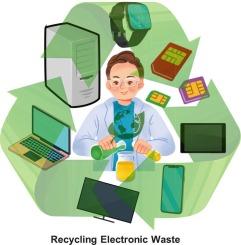Recent advances in the recycling of precious metals using sustainable chemistry
IF 23.5
1区 化学
Q1 CHEMISTRY, INORGANIC & NUCLEAR
引用次数: 0
Abstract
Precious metals (PMs) such as silver, gold, palladium, platinum, and rhodium are used not just in traditional industries like jewelry, but also in modern electronics, medicine, catalysis and others. Their scarcity, as well as the environmental impact of current extraction procedures that frequently include harmful compounds such as cyanide and mercury, provide substantial global issues. With a growing interest in sustainable chemistry, researchers are developing eco-benign ways to extract PMs from secondary sources, like electronic waste, spent catalysts which frequently have greater PM concentrations. This review presents a contemporary analysis of PM recovery with focus on underexplored and emergent avenues, such as bio-based leaching, mechanochemistry, photocatalysis, ionic liquids and deep eutectic solvents, and computationally driven ligand design, in addition to reviewing conventional procedures. Sustainability criteria including toxicity, energy use, recyclability, and life-cycle assessment (LCA) are prioritized. Comparative tables and cross-cutting studies reveal which techniques are industrially scalable, which are still in proof-of-concept stage, and where knowledge gaps persist. This review gives a unique perspective on chemical innovation and sustainability evaluation, complementing existing surveys and providing actionable information for academics and industries seeking greener PM recovery.

利用可持续化学回收贵金属的最新进展
贵金属(pm),如银、金、钯、铂和铑,不仅用于珠宝等传统行业,还用于现代电子、医药、催化和其他行业。稀土的稀缺性,以及目前的提取工艺对环境的影响,往往包括氰化物和汞等有害化合物,构成了重大的全球性问题。随着人们对可持续化学的兴趣日益浓厚,研究人员正在开发一种生态友好的方法,从二次来源中提取PM,如电子废物,废弃的催化剂,通常具有更高的PM浓度。这篇综述介绍了PM回收的当代分析,重点是未被开发和新兴的途径,如生物基浸出、机械化学、光催化、离子液体和深度共晶溶剂,以及计算驱动的配体设计,除了回顾传统的程序。可持续性标准包括毒性、能源使用、可回收性和生命周期评估(LCA)。对比表和交叉研究揭示了哪些技术在工业上是可扩展的,哪些仍处于概念验证阶段,以及哪些知识差距仍然存在。本综述为化学创新和可持续性评估提供了独特的视角,补充了现有的调查,并为寻求更环保的PM回收的学者和行业提供了可操作的信息。
本文章由计算机程序翻译,如有差异,请以英文原文为准。
求助全文
约1分钟内获得全文
求助全文
来源期刊

Coordination Chemistry Reviews
化学-无机化学与核化学
CiteScore
34.30
自引率
5.30%
发文量
457
审稿时长
54 days
期刊介绍:
Coordination Chemistry Reviews offers rapid publication of review articles on current and significant topics in coordination chemistry, encompassing organometallic, supramolecular, theoretical, and bioinorganic chemistry. It also covers catalysis, materials chemistry, and metal-organic frameworks from a coordination chemistry perspective. Reviews summarize recent developments or discuss specific techniques, welcoming contributions from both established and emerging researchers.
The journal releases special issues on timely subjects, including those featuring contributions from specific regions or conferences. Occasional full-length book articles are also featured. Additionally, special volumes cover annual reviews of main group chemistry, transition metal group chemistry, and organometallic chemistry. These comprehensive reviews are vital resources for those engaged in coordination chemistry, further establishing Coordination Chemistry Reviews as a hub for insightful surveys in inorganic and physical inorganic chemistry.
 求助内容:
求助内容: 应助结果提醒方式:
应助结果提醒方式:


